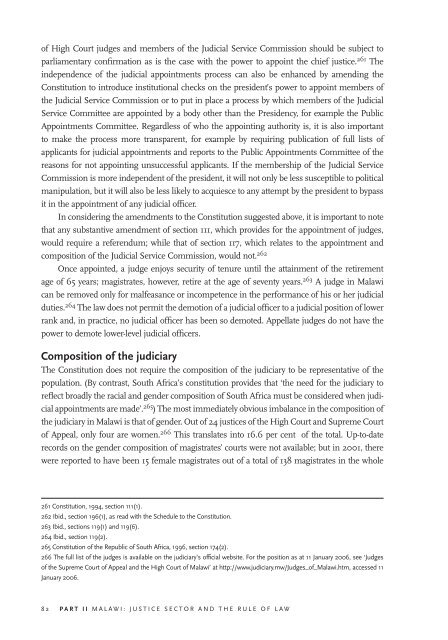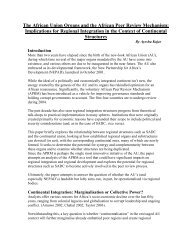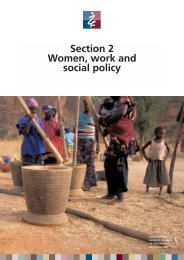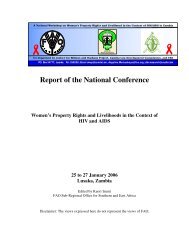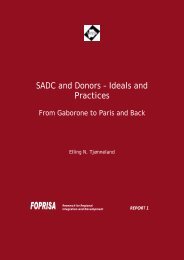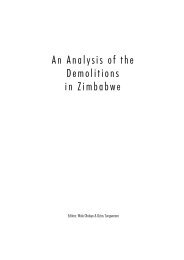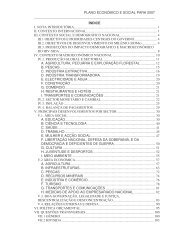Justice Sector and the Rule of Law - AfriMAP
Justice Sector and the Rule of Law - AfriMAP
Justice Sector and the Rule of Law - AfriMAP
Create successful ePaper yourself
Turn your PDF publications into a flip-book with our unique Google optimized e-Paper software.
<strong>of</strong> High Court judges <strong>and</strong> members <strong>of</strong> <strong>the</strong> Judicial Service Commission should be subject toparliamentary confirmation as is <strong>the</strong> case with <strong>the</strong> power to appoint <strong>the</strong> chief justice. 261 Theindependence <strong>of</strong> <strong>the</strong> judicial appointments process can also be enhanced by amending <strong>the</strong>Constitution to introduce institutional checks on <strong>the</strong> president’s power to appoint members <strong>of</strong><strong>the</strong> Judicial Service Commission or to put in place a process by which members <strong>of</strong> <strong>the</strong> JudicialService Committee are appointed by a body o<strong>the</strong>r than <strong>the</strong> Presidency, for example <strong>the</strong> PublicAppointments Committee. Regardless <strong>of</strong> who <strong>the</strong> appointing authority is, it is also importantto make <strong>the</strong> process more transparent, for example by requiring publication <strong>of</strong> full lists <strong>of</strong>applicants for judicial appointments <strong>and</strong> reports to <strong>the</strong> Public Appointments Committee <strong>of</strong> <strong>the</strong>reasons for not appointing unsuccessful applicants. If <strong>the</strong> membership <strong>of</strong> <strong>the</strong> Judicial ServiceCommission is more independent <strong>of</strong> <strong>the</strong> president, it will not only be less susceptible to politicalmanipulation, but it will also be less likely to acquiesce to any attempt by <strong>the</strong> president to bypassit in <strong>the</strong> appointment <strong>of</strong> any judicial <strong>of</strong>ficer.In considering <strong>the</strong> amendments to <strong>the</strong> Constitution suggested above, it is important to notethat any substantive amendment <strong>of</strong> section 111, which provides for <strong>the</strong> appointment <strong>of</strong> judges,would require a referendum; while that <strong>of</strong> section 117, which relates to <strong>the</strong> appointment <strong>and</strong>composition <strong>of</strong> <strong>the</strong> Judicial Service Commission, would not. 262Once appointed, a judge enjoys security <strong>of</strong> tenure until <strong>the</strong> attainment <strong>of</strong> <strong>the</strong> retirementage <strong>of</strong> 65 years; magistrates, however, retire at <strong>the</strong> age <strong>of</strong> seventy years. 263 A judge in Malawican be removed only for malfeasance or incompetence in <strong>the</strong> performance <strong>of</strong> his or her judicialduties. 264 The law does not permit <strong>the</strong> demotion <strong>of</strong> a judicial <strong>of</strong>ficer to a judicial position <strong>of</strong> lowerrank <strong>and</strong>, in practice, no judicial <strong>of</strong>ficer has been so demoted. Appellate judges do not have <strong>the</strong>power to demote lower-level judicial <strong>of</strong>ficers.The Constitution does not require <strong>the</strong> composition <strong>of</strong> <strong>the</strong> judiciary to be representative <strong>of</strong> <strong>the</strong>population. (By contrast, South Africa’s constitution provides that ‘<strong>the</strong> need for <strong>the</strong> judiciary toreflect broadly <strong>the</strong> racial <strong>and</strong> gender composition <strong>of</strong> South Africa must be considered when judicialappointments are made’. 265 ) The most immediately obvious imbalance in <strong>the</strong> composition <strong>of</strong><strong>the</strong> judiciary in Malawi is that <strong>of</strong> gender. Out <strong>of</strong> 24 justices <strong>of</strong> <strong>the</strong> High Court <strong>and</strong> Supreme Court<strong>of</strong> Appeal, only four are women. 266 This translates into 16.6 per cent <strong>of</strong> <strong>the</strong> total. Up-to-daterecords on <strong>the</strong> gender composition <strong>of</strong> magistrates’ courts were not available; but in 2001, <strong>the</strong>rewere reported to have been 15 female magistrates out <strong>of</strong> a total <strong>of</strong> 138 magistrates in <strong>the</strong> whole


